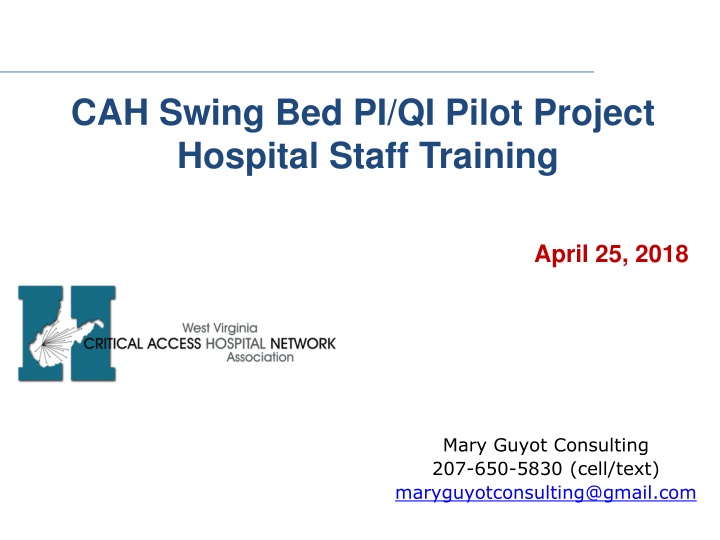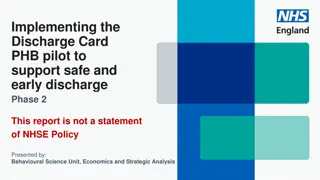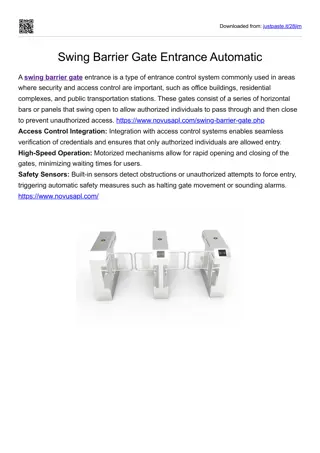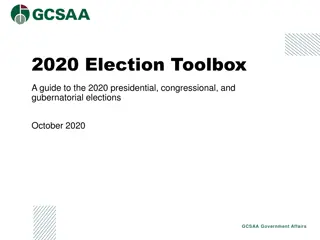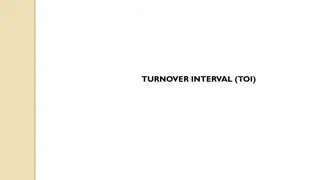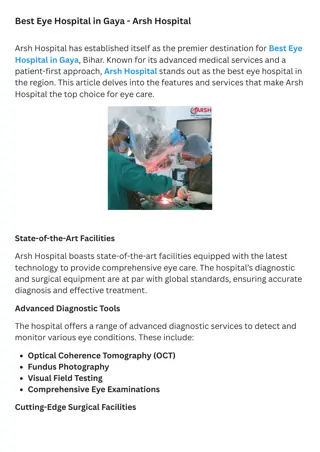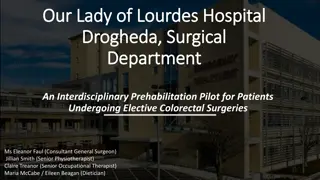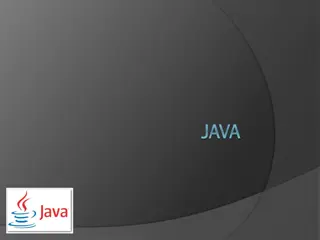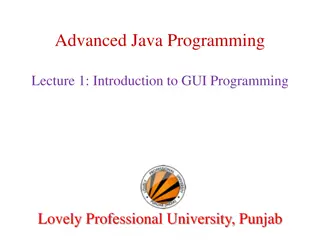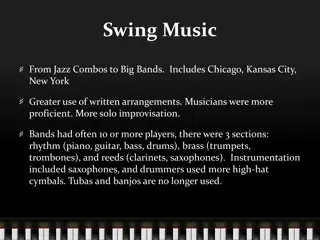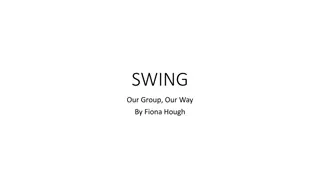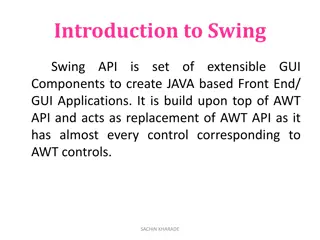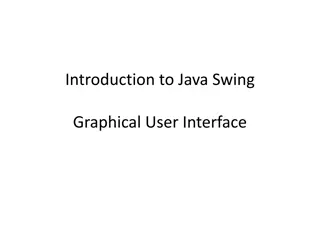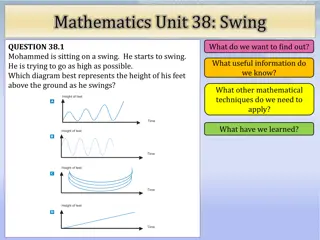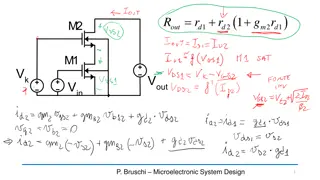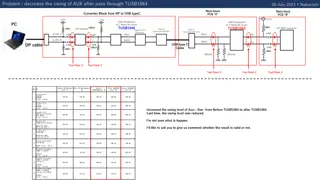Hospital Staff Training - CAH Swing Bed Pilot Project
The hospital staff training for the CAH Swing Bed PI/QI Pilot Project on April 25, 2018, includes a review of necessary sections for SB admissions, form discussions, coding tips, follow-up call processes, and more. The agenda covers sign-ins, data reports, therapy reception percentages, and web-based form usage. Detailed assessments are required for all patients, covering various aspects from admission demographics to discharge disposition. The training also involves high-level reviews of each section of the collection tool.
Download Presentation

Please find below an Image/Link to download the presentation.
The content on the website is provided AS IS for your information and personal use only. It may not be sold, licensed, or shared on other websites without obtaining consent from the author.If you encounter any issues during the download, it is possible that the publisher has removed the file from their server.
You are allowed to download the files provided on this website for personal or commercial use, subject to the condition that they are used lawfully. All files are the property of their respective owners.
The content on the website is provided AS IS for your information and personal use only. It may not be sold, licensed, or shared on other websites without obtaining consent from the author.
E N D
Presentation Transcript
CAH Swing Bed PI/QI Pilot Project Hospital Staff Training April 25, 2018 Mary Guyot Consulting 207-650-5830 (cell/text) maryguyotconsulting@gmail.com
Agenda 1) Sign-in by hospital + data report 2) Review of sections that must be completed for all SB admissions 3) Review form and discuss questions staff has 4) High level review of the form and coding tips 5) Planned process for 30 day follow up call 6) Reports from Stroudwater for quarterly meetings 2
Sign-In Roll call Hospitals to report # of SB admissions since April 1, 2018 What % of those admissions received therapy (PT/OT) Who has started using the web based form? Issues? Any overall road blocks? 3
Will all patients require an assessment? For this project, every admission, regardless of payor will require all info re: Admission Demographics Unique ID # DOB Entered from Payor source Risk Adjustment Data Admitting medical condition Major surgery in past 100 days Prior functioning status before admission to the hospital Prior device use Pressure ulcer/injury on admission to SB Communication impairment History of falls in past 6 months BIMS Score or Memory Recall if patient can t do BIMS Urinary & Bowel incontinence Tube feeding Comorbidities Discharge Demographics D/C Disposition Readmission within 30 days post discharge (same or different condition) Includes IP admissions, ED visits, placed in Observation Some patients will be excluded from the sections re Functionality and Mobility - see slide 17 4
High level review of each section of the collection tool and discussion of Q&A 5
Demographics 1. Unique Patient Identifier as decided by hospital such as act. # or something totally different but you must have a system where you would remember how to access the info. 2. DOB and SB Adm. Date is self-explanatory 6
Demographics - Updated (prior to acute care hospitalization that preceded swing bed stay) 1. Unique Patient Identifier as decided by hospital such as act. # or something totally different but you must have a system where you would remember how to access the info. Self-explanatory Any questions? 2. DOB and SB Adm. Date is self-explanatory 7
Payor 1. Medicare = generic/general 2. Medicare Advantage such as HMO 3. Medicaid only applies if primary not to be used for Medicare/Medicaid in this case you would choose Medicare 4. Commercial all other insurance 5. Self-pay self-explanatory 6. Other = RR, VA, Prison etc The questions is: what will be the primary payor? 8
Primary Medical Condition/Reason for SB Admission Note: PRIMARY medical condition category documented by the provider 1. These are for grouping purpose only we don t admit for a stroke but s/p stroke so any type of stroke and sequelae would be 01 2. Pay attention to hip & knee replacement vs FX and other multiple trauma 3. Debility, Cardiorespiratory condition could be for HBP, COPD, CHF, post-CABG, Asthma, etc 4. Medically complex conditions examples can be multiple medical issues post surgery, a patient who is diabetic, on dialysis and in for wound care. acquired multisystem disease 5. Other is for when you cannot find a code that will fit the others IP surgery within 100 days prior to SB admission 9
Prior Functioning Before Hospital Admission 1. Independent NO Assistance from a helper 2. Needed some help self-explanatory 3. Dependent a helper is a must 4. Unknown only to be used if the patient cannot say and there are no family/friends who can inform us. 5. Not applicable one would expect that you would have a code 1, 2 or 3 for (A) self- care because that is a must but feasible that you would have N/A for ambulation and stairs if the patient does not do that. Same goes for functional cognition 10
Prior Device Use Before Hospital Admission Note: Devices & aids that the patient used prior to being admitted to acute for the current illness/medical condition If patient was not using a device prior to hospitalization but was given a walker or w/c during the acute stay for his/her ambulation or for transfer off unit while in SB the answer would be Z none of the above 11
Unhealed Pressure Ulcer/Injury Note: Pressure ulcer/Injury = pressure ulcers due to any reason and injury refers to deep tissue injury so for instance, a skin tear would not constitute a pressure ulcer/injury The primary cause of the skin alteration is related to pressure for this purpose. For instance, mucosal pressure ulcers are not staged using the skin pressure ulcer staging system because anatomical tissue comparisons cannot be made. Therefore, mucosal ulcers (for example, those related to nasogastric tubes, nasal oxygen tubing, endotracheal tubes, urinary catheters, etc.) should not be coded here. 12
Understand/Understood - Falls Note: clearly read the definitions this is not assessing speaking, language or hearing for instance, the patient does not have to be able to speak everything to be understood or usually understood if they can sign or point and/or write or need a translator. Falls could have occurred at home, community, NH, etc or while an IP in acute. 13
Cognitive Note: BIMS (Brief Interview for Mental Status) should be attempted on all patients except those who are never/rarely understood Staff must follow instructions exactly as on the tool reflects to administer BIMS Skip to Memory/Recall only if patient cannot do BIMS Memory/Recall section is skipped if BIMS was administered 14
Urinary/Bowel Incontinence TPN/Tube Feeding Note: 1. # 9 is a new option - not rated, patient has a catheter, ostomy, or no urine output (such as in urinary for patients on dialysis). This section may need all 3 days to assess may not be able to determine in 1 or 2 days. 2. TPN and Tube feeding only applies if present or initiated during the SB stay not be counted if discontinued before SB admission 15
Comorbidities Note: 1. Comorbidities documented by the provider in H&P or progress notes 2. Must be active hx of if not impacting the treatment plan is not to be checked off 3. Ok to discuss with the provider if obvious comorbidity but provider did not document 16
Exceptions to Full Assessment Self Care & Mobility Data will be completed for all payors minus the following exceptions: Still an exclusion if receiving PT for wound debridement only! 17
Function/Mobility 1. Admission assessment must be completed within 3 calendar days of admission (including day of admission) 2. Read the description of the items to be coded very carefully do not read into it more than its asking (see later examples) 3. Carefully read the coding key descriptions and choose what best fits the patient always look at the 2 descriptions before and after the one you think it is to make sure you have the correct one 4. All assessment items must be attempted to be coded otherwise a reason for no attempt must be coded 18
Function/Mobility 1. Same items will be tested on discharge 2. Must be completed within 3 calendar days of discharge including the day of discharge 3. Same coding principles apply to discharge assessments 4. Again, all assessment items must be attempted to be coded otherwise a reason for no attempt must be coded 5. Patients should be allowed to perform activities as independently as possible, as long as they are safe for both admission & discharge assessments. 19
Basic CMS Guidelines to Coding Function & Mobility When coding the patient s usual performance, effort refers to the type and amount of assistance the helper provides in order for the activity to be completed. The 6- point rating scale definitions include the following types of assistance: setup/cleanup, touching assistance, verbal cueing, and lifting assistance. 06 - Independent Patient completes the activity by him/herself with no assistance from a helper 05 - Setup or clean up assistance Helper sets up or cleans up; patient completes activity. Helper assists only prior to or following the activity 20
Basic CMS Guidelines to Coding Function & Mobility 04 - Supervision or touching assistance Helper provides verbal cues and/or touching/steadying and/or contact guard assistance as patient completes activity. Assistance may be provided throughout the activity or intermittently 03 - Partial/moderate assistance Helper does LESS THAN HALF the effort. Helper lifts, holds, or supports trunk or limbs, but provides less than half the effort 02 - Substantial/maximal assistance Helper does MORE THAN HALF the effort. Helper lifts or holds trunk or limbs and provides more than half the effort 01 - Dependent Helper does ALL of the effort. Patient does none of the effort to complete the activity. Or, the assistance of 2 or more helpers is required for the patient to complete the activity 21
Basic CMS Guidelines to Coding Function & Mobility All functions must be attempted unless there is a reason why not as follows: 07 - Patient refused do all possible to convince them to participate 09 - Not applicable Not attempted and the patient did not perform this activity prior to the current illness, exacerbation, or injury for instance, if patient was not doing stairs before then its NA, if patient does not ambulate or uses w/c in community then those items are NA etc 10 - Not attempted due to environmental limitations (e.g., lack of equipment, weather constraints) for example, there are no 12-step stairs in the hospital (gym or stairs between hospital floors etc Remember that if the weather is not good to test outdoors on day 1, do not use not attempted due to environmental limitations unless the weather does not change for all 3 days 88 - Not attempted due to medical condition or safety concerns for instance you may not be able to assess stairs within the 1st 3 days for post stroke, or maybe their medical issues are still not sufficiently stable to attempt some of the testing 22
Basic CMS Guidelines to Coding Function & Mobility Assess the patient s self-care status based on: direct observation, the patient s self-report, family reports, and direct care staff reports documented in the patient s medical record during the assessment period Interdisciplinary team approach is recommended but regardless, a chart review should support the information reported on the tool Coding on admission should reflect the person s baseline admission functional status, and is based on a clinical assessment that occurs soon after the patient s admission. 23
Basic CMS Guidelines to Coding Function & Mobility The admission functional assessment, when possible, should be conducted prior to the person benefitting from treatment interventions in order to determine a true baseline functional status on admission. If treatment has started, for example, on the day of admission, a baseline functional status assessment can still be conducted at that time. Treatment should not be withheld in order to conduct the functional assessment. Activities may be completed with or without assistive device(s). Use of assistive device(s) to complete an activity should not affect coding of the activity. 24
General Coding Tips Coding Tips for - Lying to Sitting on Side of Bed Lying to sitting on side of bed, indicates that the patient transitions from lying on his/her back to sitting on the side of the bed with feet flat on the floor and sitting upright on the bed without back support. The clinician is to assess the patient s ability to perform each of the tasks within this activity and determine how much support the patient requires to complete the activity. Clinical judgment should be used to determine what is considered a lying position for that patient. If the patient s feet do not reach the floor upon lying to sitting, the clinician will determine if a bed height adjustment or a foot stool is required to accommodate foot placement on the floor/footstool. Back support refers to an object or person providing support of the patient s back. 25
General Coding Tips Coding Tips for Chair/Bed-to-Chair Chair/bed-to-chair transfer, begins with the patient sitting in a chair or wheelchair or sitting upright at the edge of the bed and returning to sitting in a chair or wheelchair or sitting upright at the edge of the bed. The activities of Sit to lying and Lying to sitting on the side of the bed are two separate activities that are not assessed as part of Chair/Bed-to-Chair If a mechanical lift is used to assist in transferring a patient for a chair/bed-to-chair transfer and two helpers are needed to assist with a mechanical lift transfer, then Code 01 - Dependent, even if the patient assists with any part of the chair/bed-to-chair transfer. 26
General Coding Tips If the patient performs the activity more than once during the assessment period and the patient s performance varies, coding should be based on the patient s usual performance, which is identified as the patient s usual activity/performance for any of the Self-Care or Mobility activities, not the most independent or dependent performance over the assessment period. Therefore,if the patient s Self-Care performance varies during the assessment period, report the patient s usual performance, not the patient s most independent performance and not the patient s most dependent performance. A provider may need to use the entire 3-day assessment period to obtain the patient s usual performance. For the Discharge assessment, code the patient s discharge functional status, based on a clinical assessment of the patient s performance that occurs as close to the time of the patient s discharge as possible to capture all areas of improvement possible 27
General Coding Tips The intention of the wheelchair items is to assess the patient s use of a wheelchair for self-mobilization at admission and discharge when appropriate. The clinician uses clinical judgment to determine if the patient s use of a wheelchair is appropriate for self-mobilization due to the patient s medical condition or safety. Do not code wheelchair mobility if the patient only uses a wheelchair when transported between locations within the facility. Only code wheelchair mobility based on an assessment of the patient s ability to mobilize in the wheelchair. If the patient walks and is not learning how to mobilize in a wheelchair, and only uses a wheelchair for transport between locations within the facility, code the wheelchair/scooter gateway items at admission and/or discharge items as follows: Does the patient use a wheelchair/scooter as 0, No. Answering the question in this way invokes a skip pattern which will skip all remaining wheelchair questions. Remember that it is very possible that the patient starts with a wheelchair but no longer is the case on discharge only walking will apply at discharge. 28
Activity Definition Eating: The ability to use suitable utensils to bring food and/or liquid to the mouth and swallow food and/or liquid once the meal is placed before the patient Oral hygiene: The ability to use suitable items to clean teeth. Dentures (if applicable): the ability to insert and remove dentures into and from the mouth, and manage denture soaking and rinsing with use of equipment Toileting hygiene: The ability to maintain perineal hygiene, adjust clothes before and after voiding or having a bowel movement. If managing an ostomy, include wiping the opening but not managing the equipment Shower/bathe self: The ability to bathe self, including washing, rinsing, and drying self (excludes washing of back and hair). Does not include transferring in/out of tub/shower 29
Activity Definition Upper body dressing: The ability to dress and undress above the waist, including fasteners, if applicable Lower body dressing: The ability to dress and undress below the waist, including fasteners; does not include footwear Putting on/taking off footwear: The ability to put on and take off socks and shoes or other footwear that is appropriate for safe mobility; including fasteners, if applicable Roll left and right: The ability to roll from lying on back to left and right side, and return to lying on back on the bed Sit to lying: The ability to move from sitting on side of bed to lying flat on the bed 30
Activity Definition Lying to sitting on side of bed: The ability to move from lying on the back to sitting on the side of the bed with feet flat on the floor, and with no back support Sit to stand: The ability to come to a standing position from sitting in a chair, wheelchair, or on the side of the bed Chair/bed to chair transfer: The ability to transfer to and from a bed to a chair (or wheelchair) Toilet transfer: The ability to get on and off a toilet or commode Car transfer: The ability to transfer in and out of a car or van on the passenger side. Does not include the ability to open/close door or fasten seat belt 31
Activity Definition Walk 10 feet: Once standing, the ability to walk at least 10 feet in a room, corridor, or similar space Note: Does the patient walk? Mr. Z currently does not walk, but a walking goal is clinically indicated. Coding: 88 due to clinically unsafe on admission but it would be 09 N/A if she did not walk prior to his acute admission stay. Same goes to walking 50 ft and 150 ft. Walk 50 feet with two turns: Once standing, the ability to walk at least 50 feet and make two turns Note: The turns included in these item (walking or wheeling 50 feet with 2 turns) are 90-degree turns. The turns may be in the same direction (two 90- degree turns to the right or two 90-degree turns to the left) or may be in different directions (one 90-degree turn to the left and one 90-degree turn to the right). The 90-degree turn should occur at the person s ability level and can include use of an assistive device (for example, cane or wheelchair) Walk 150 feet: Once standing, the ability to walk at least 150 feet in a corridor or similar space 32
Activity Definition Walking 10 feet on uneven surfaces: The ability to walk 10 feet on uneven or sloping surfaces (indoor or outdoor), such as turf or gravel 1 step (curb): The ability to go up and down a curb and/or up and down one step 4 steps: The ability to go up and down four steps with or without a rail 12 steps: The ability to go up and down 12 steps with or without a rail Picking up object: The ability to bend/stoop from a standing position to pick up a small object, such as a spoon, from the floor Wheel 50 feet with two turns: Once seated in wheelchair/scooter, the ability to wheel at least 50 feet and make two turns Wheel 150 feet: Once seated in wheelchair/scooter, the ability to wheel at least 150 feet in a corridor or similar space 33
Examples on How to Code Has any hospital used the samples to teach your staff are samples brought to ITD meetings? See WORD document with multiple examples on how to code each item for Function & Mobility. Recommended use of the tool 1. Review info as a team so that all are on the same page 2. Cut & paste some for testing/competency purpose 3. Bring to ITP meetings to assist in coding 34
Discharge Data Self explanatory but make sure you have a good system to enter this info for instance both D/C to home and Home with HH would be coded 01 35
30-Day Follow-up Status We understand that getting information regarding a hospital use other than yours may be difficult to get information from the patient hence all the choices on the next Slide. We do expect that you will be able to get info from HIM for patients who used your CAH. 36
30-Day Follow-up Status Check all that apply Check all that applies Take the time to read and let s discuss any and all questions . 37
Data Entry & Quarterly reports SB Long Form SB Short Form Any questions on web-base access I can pass on to Stroudwater? What will reports look like? Will you be able to access different reports? Please email me info you hope will be compared. 38
CAH SB PI/QI Pilot Project Next Step 1. May/June 2018 another conference call to be scheduled based on # of questions I will be getting 2. May/June Stroudwater may schedule a webinar - based on issues they are seeing 3. Please text/email me if you have any questions regarding coding and/or processes 4. Contact Paula from Stroudwater if issues with web-based data entry and cc Dianna Iobst and myself 5. Mark your calendar On-site meeting will be on Tuesday July 24, 2-18 39
